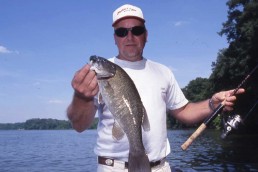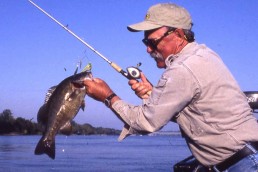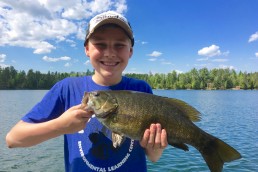Pickwick Lake’s Summer Bronzebacks, An interview with Barry Holt
SHARE THIS POST
This month our fishing expert is guide Barry Holt from Sheffield, Ala. I’ve fished
with Barry many times over the years in all seasons. If anyone can put us on fish, it’s Barry. So let’s pick his brain about catching smallies on Pickwick Lake in the good-old summertime.
MidWest Outdoors: We all know Pickwick Lake is a super smallie lake. Why is that?
Barry Holt: Pickwick Lake is the southernmost impoundment in Alabama that has smallmouth bass. The lake extends into Tennessee too. Being at the southern end of their range gives them a longer growing season and the abundant food supply makes Pickwick a good place to catch a lot of smallmouths, and big ones too.
MWO: Which part of the lake do you fish in summer?
Holt: You can always catch smallies below Wilson Dam, and we’ll get back to that area in a minute, but I prefer the area near the Natchez Trace Parkway in the summer. Smallmouths are starting to pull up on the ledges along the river channels and humps. They won’t be bank-oriented; they will be near deep water. Most of the big smallmouths are caught in what we call the Natchez Trace Area. I can’t give away my favorite fishing holes, but Bluff Creek, Brush Creek and the Waterloo, Ala. areas of Pickwick Lake are where I fish this time of the year.
MWO: Where do you recommend someone fish if they don’t know the area?
Holt: Looking on my TVA map of the Tennessee River, these are places worth fishing: the mouth of Bear Creek (south side of the lake at river-mile 225) should be a hot spot when current is slow in the main river, Second Creek at Waterloo (north side at river-mile 227), Ross Branch (south side at river-mile 229.8), Bull Creek (north side at river-mile 234), Colbert Creeks (one on the north and on the south side of the Tennessee River at river-mile 236), Moon Spring Branch (south side at river-mile 237.6), Malone Creek (south side at river-mile 240.5), Mulberry Creek (south side at river-mile 241.5) and Cane Creek (south side at river-mile 244). I’m not giving away my spots, but a fisherman can hit some of these areas and catch some fish.
MWO: While you’re naming names, let’s go upstream to pick up those hot spots near Wilson Dam. I know you consider the dam area to be a secondary smallmouth spot in the summer.
Holt: Yeah, the tailwaters are always a good place to fish for smallies, but you won’t find the big ones you’ll find down near the Natchez Trace Parkway area.
MWO: Where are the hot spots at the dam?
Holt: The vents on the south side of the dam hold fish year ‘round and smallies are active when there is some current. Just below the dam is Jackson Island near midstream. Smallies hold here, but you must be careful when navigating these waters because the rocky bottom is very close to the surface. This is the area called Muscle Shoals. That’s M-U-S-C-L-E, not M-U-S-S-E-L Shoals—it was hard work to get boats through the shallow waters before the dam was built. The land north of Jackson Island is three-mile-long Patton Island. The best fishing is at the downstream tip. The ship channel runs along the north side of the island to the locks in Wilson Dam, so be aware of barges entering and exiting. Downstream, on the south side of the river at river-mile 254, begins a two-mile-long rock pile; you know how I like the rock channel because we always fish it. The water is 20 feet deep on both sides of the rocks. About midway down the rock piles on the north side of the river begins Seven-Mile Island. On the north side is Back Channel—called “Little River” by us locals—that has a series of islands with water 16 feet deep between them and stumps 14 feet high. This is another place to bump your prop if you are not careful, but it’s worth fishing because smallmouths stay here year ‘round.
Are you enjoying this post?
You can be among the first to get the latest info on where to go, what to use and how to use it!
MWO: Let’s talk about baits you’d use near the Natchez Trace Parkway.
Holt: If you’d like to catch the larger fish, there are islands and submerged islands along the channel. The ledges on these structures are where you want to put your bait. I put in before sunrise to catch smallmouths on top with a Zara Spook or Pop-R; I look for any topwater movement from bass chasing shad. This won’t last long, about an hour after sunrise, but it’s the best time to get some topwater action. About dusk, I go back to casting topwater baits if I see any bass busting shad. The mouths at the deeper coves that have pea gravel points are worth fishing. At places like this I like to use a Carolina rig with a lizard. If that fails, live bait will work.
MWO: How do you fish when it’s the hottest part of the day?
Holt: As the sun gets higher, I head for the main channel ledges and sling crankbaits. I’ll cast a DD22 in Chartreuse with a Black back or Bagley’s Dredge. I want the bait to run down 10 to 12 feet deep—that’s where the smallies are. I cast to the tops of the flats and humps, and then retrieve the crank into deep water to bump the stumps.
MWO: You mentioned using live bait. What do you use?
Holt: When times are tough, I’ll cast a shiner at a hump. I’ll put a shiner on a 2/0 hook and I use either a BB split shot or no weight at all. I let the current take the bait downstream to the hump, giving it line from a spinning reel until it’s in place. Then I let the shiner drift and flutter over the backside of the hump; that’s where the fish will be if there is current. If there is no current, I back away from the hump to fish deeper water around the base.
MWO: Where do you anchor?
Holt: Boat position is critical when fishing the humps. You want to keep your boat over deep water. You don’t ever want your boat to get over the fish—it’ll spook ’em into the next county. Try to keep the nose of your boat into the current so you can maintain control. I keep the boat off the edge of the drop and cast to the top of the hump to work my bait down it. Gravel and shells are two things to look for on the humps. If you find one of these, you are likely to find smallmouths. I’ve found that fishing a flat mud bottom is unproductive. Smallmouths want a hump to have rocks or shells and some stumps.
MWO: Since it’s summer, I know you like to fish at night. Tell us how you do it.
Holt: I may get some arguments about this, but I think fishing during the day is better than at night. Night fishing can be real good, but in summer the fish roam more at night. And it’s rare that I’ll catch a fish at night in less than 6 feet of water, so they aren’t roaming the banks. During the day they stay around the humps and that’s when I find them bunched up—the fishing is a lot better.
MWO: I stand corrected. I was thinking about our late fall night trip that was so productive. For the sake of not having heat stroke, how would someone fish at night?
Holt: If you want to night-fish, the rock piles are usually productive for anglers casting a 1/4- to 3/8-ounce, single-spin Colorado blade, and a black and red or solid black spinnerbait. A Number 11 Uncle Josh pork chunk added to the hook increases the silhouette; bass will see it against the nighttime sky. You should also cast onto the rock piles and yo-yo it back through the rocks. MWO
MWO
SHARE THIS POST
Did you enjoy this post?
You can be among the first to get the latest info on where to go, what to use and how to use it!
Vernon Summerlin
For more than 30 years, Vernon Summerlin has produced outdoor articles and books that can be found on Amazon; most recently How to Analyze a Bass Hole: Think and Catch’em! He is the recipient of more than 40 awards for magazine and newspaper articles, TV, radio, photography and books.



